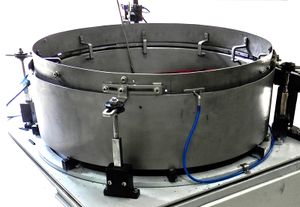Rotary Feeders
Rotary Feeders or Vibratory Bowl Feeders, have been around since the early part of the twentieth century. Till date no major alternative for the same has been invented. However, a Rotary or Centrifugal Feeders which uses a motorised drive, is definitely an alternative.
Advantages
There are many advantages of Rotary Feeders vis a vis vibratory bowl feeders, the major one being the speed or feed rate. Rotary or Centrifugal Feeders work at very high speeds and one can achieve a total feed rate of up to 50 meters per minute as against just about 12 meters per minute in case of even high speed vibratory bowl feeders. Secondly, there being no vibrations and only mechanical items, rotary feeders are more acceptable to a lot of customers who are afraid of the reliability of vibratory bowl feeders in the long run.
Disadvantages
However, the major drawback of a Rotary or Centrifugal Feeder is that it is not possible to orient a lot of parts in it, especially due to the fact that there are no vibrations and the movement of the parts is very fast. Further, in most of the cases, air jets are required for orientation, while in a vibratory bowl feeder, air jets are required only occasionally. Thus the running cost of a Rotary Feeder is always costly compared to a vibratory bowl feeder.
Another disadvantage of a Rotary feeder is that due to the positive pressure generated because of the rotating disc, the parts being fed are thrown against each other and against the wall of the feeder. This can result in damages to the parts. However, in a properly manufactured Rotary Feeder, this can certainly be avoided. Against this components or parts do not get damaged at all in a vibratory bowl feeder. Even brittle and delicate parts can be handled in a vibratory bowl feeder. One more disadvantage of a Rotary Feeder is that the number of components which are loaded in a Rotary or Centrifugal Feeder have to be limited to ensure there is no jamming or blockage. Hence, invariably a stock hopper or a hopper elevator is required in order to replenish the Rotary Feeder on a regular basis. This adds to the cost of a Rotary Feeder.
Design
Manufacturing of a Rotary or Centrifugal Feeder also requires a lot of expertise, which few posses and most manufactured Rotary Feeders are quite crude and result in jamming and damage to the components being fed. However, Rotary / Centrifugal Feeders can be is rugged and highly robust for feeding of parts which require high speed feeding. The build quality too is excellent with all the components touching parts being made in stainless steel. A dual drive can be used for Rotary Feeders. Three Phase AC geared motors are used for this purpose. Standard units come with a Variable Frequency Drive so that variable speed can be offered, which helps adjust the feeding speed according to the actual requirement of the user. A lot of parts, even those requiring orientation can be fed through a Rotary Feeder like bottle caps, cylindrical rollers, needle rollers, flat and cylindrical drippers, bearing races, bearing rings etc. Even parts requiring critical component orientation can be oriented and fed through the double disc design of the Rotary Feeders at a high speed. However, orientation in a Rotary Feeder may not be possible for some parts and in such cases; one has to opt for a vibratory bowl feeder.
Rotary feeder can be used for flat drippers where the curved face is required to be up. A speed of 800 parts per minute can be achieved for a 40 mm long flat dripper as against this, you could achieve a speed of just 200 parts per minute in case of a vibratory bowl feeder for the same component.
Video
You can watch the videos of the Flat Dripper Rotary Feeders and a Round Dripper Rotary Feeder.
